
A former hi-fi colleague of yore recently posted on social media a freeze-frame from the AppleTV Plus show Invasion in which he had spotted an old Cyrus One amplifier in the background.
I congratulated his eagle-eyed (if slightly sad-old-audiophile) observation, and in passing I explained how my household watches shows from all the various video streaming services, but we only ever pay for one, and sometimes not even that.
How so? I’m not talking about the dubious ways some people wangle these things for free – none of your VPNing, no dodgy BitTorrenting or questionable set-top box, etc. No, this is all legal, and I pay them all.
And it seems a fairly obvious method to me, but given my former colleague’s reaction, and the fact that I don’t know anyone else who does it, I thought I might share it more widely here, pour encourager les autres, as it were, by which I mean those of you who run half a dozen streaming subscriptions all at the same time, and probably stare in horror at your credit card statements as a result.
Mean or lean?
I realise that my solution does rather indicate that I might be thought something of a skinflint, though I’d question if that can truly be inferred from a preference not to hand Netflix nearly AU$266 a year, the current price of their premium service with Ultra HD streaming (and so the quality I need to review the TVs I test for the pages of Sound+Image magazine).
But I do admit to having an economical nature. I was raised back in England by a mother who was herself raised during the Second World War, when you had to bash the ends of soap bars together to make a new one, and when half the village would come round to stare at a banana if you managed to get one. (She still does the soap-bar thing, I believe, though village banana gatherings are long in the past.)
So that’s my excuse.
Get the What Hi-Fi? Newsletter
The latest hi-fi, home cinema and tech news, reviews, buying advice and deals, direct to your inbox.
Oh, the video subscription thing, paying for only one – how do we do that? Simples. We subscribe to one video streaming service, and we binge it dry of everything we want to watch. Then we cancel our subscription immediately, and start on another service. A month is usually enough to get through everything; Netflix has so much stuff that we’re often on there for two or three months before we get through it all and cancel again.
No service currently has any penalty for cancelling, other than the few bucks you might save by having an annual subscription, and that’s only with some of them – not Netflix, I note.
Sometimes you can get lucky, and pay even less. Back in November I cancelled Netflix, having finished its spectacular third season of Formula 1: Drive to Survive, and I was just about to pay for a month of Disney Plus to catch the Peter Jackson Beatles films, when a story right here on What Hi-Fi informed me it was ‘Disney Plus Day’, hoorah, and would I like a month of access for AU$1.99? I certainly would, thank you very much.
So now I’m all caught up on the latest straight-to-Disney Plus Marvel releases, and I hammered out the full eight hours of Peter Jackson’s Get Back in glorious if rather optimistic Dolby Atmos. Two bucks the lot. Price of a bad coffee.
Prime mover
Amazon Prime is still more generous, and seems to be internationally disassociated, leaving room for additional benefits. If you’re an Amazon shopper, you can hardly not know that joining Amazon Prime gives you free delivery and various other benefits, including access to Amazon Prime Video.
So keen is Amazon to get you on Amazon Prime that it constantly encourages you to have a free month of it. Even if they don’t I’ll happily pay for it in December, and I sign up from Amazon UK to ensure free delivery on everything to my family over there. (Mother would be proud.) Happily, this seems to activate Amazon Prime to watch in Australia anyway, so at Christmas we binge through Amazon Prime shows.

More recently, Amazon offered me a mere week of Amazon Prime here in Australia, but for just AU$1.99. I was in the middle of ordering a book for which delivery was going to be AU$3.99, so clearly I’d be an idiot not to go Prime. So I did, got the book, and cancelled Prime the next day. It ran the full week anyway.
The following week we sent a book to my father-in-law in Ontario, Canada, using amazon.ca, which accepted my normal (global?) log-in, and immediately offered me a whole month of Amazon Prime for free. Why thank you, said I – so for a while there, against our usual rules, we had Disney Plus and Amazon Prime at the same time, for a month, for AU$1.99 the pair.
I shall perhaps atone for this extravagance by taking a couple of months off all the subscription video services, binging instead through the wealth of content free from ABC iView, SBS on Demand and the commercial free-to-air channels, from Tubi, Plex, and the library service Kanopy. There’s plenty of stuff out there to fill several months a year of payment-free binging.
Handy with a hook
I have, however, bent our household rules for AppleTV Plus, because it has proven too darned handy with a hook. This comes as a surprise to me, as when AppleTV Plus launched, I thought it a ridiculous proposition – only Apple-made shows, a noble idea, but it meant launching with hardly anything to watch.
But then I got a year of AppleTV Plus free when I bought a MacBook, which ran until a few months ago. Did I then cancel? Did I heck! Ted Lasso was dropping every Friday, and the Asimov Foundation series had started. I kept paying.

A number of the other services also seem wise to the attraction of the old-school ‘weekly drop’ of shows, more the old-school broadcasting model, going for the water-cooler effect. This can easily trap you into keeping multiple services running.
The trick, of course, is not to watch the first episode until they’re all released. When Clarice was airing on Stan in weekly drops, we deliberately didn’t subscribe to Stan until it was all over, then we subscribed for a month and binged it, along with everything else Stan had to offer us. And cancelled. See you next year, Stan.
Cheaper still?
I’m sure some readers will now be waving their arms at me to point out that most streaming services also offer a free trial period, and that they’re remarkably bad at identifying duplicate accounts which merely use a different email address. And yes, I’m aware of that, but the small print of most services usually forbids doing this, even if it works, so I can’t be recommending that here.
Besides, it requires very careful calendar-keeping; it’s rather too easy to lose track of what identity you’ve used for this latest trial or that… Anyway, artists’ rights and all that – it’s surely fair that we should pay something for the media we consume (even if you’re reading this article for free on the internet).
But I don’t see why we should pay more than we have to, so I heartily recommend my method of jumping from subscription to subscription, which not only saves money, but gives the whole family the excitement of opening up a new slab of content every time we cancel one service and start another.
Binge and cancel. Binge and cancel. It’s the future of TV viewing, for those on a budget. Except for my mother, of course, who watches only free terrestrial broadcasts.

Jez is the Editor of Sound+Image magazine, having inhabited that role since 2006, more or less a lustrum after departing his UK homeland to adopt an additional nationality under the more favourable climes and skies of Australia. Prior to his desertion he was Editor of the UK's Stuff magazine, and before that Editor of What Hi-Fi? magazine, and before that of the erstwhile Audiophile magazine and of Electronics Today International. He makes music as well as enjoying it, is alarmingly wedded to the notion that Led Zeppelin remains the highest point of rock'n'roll yet attained, though remains willing to assess modern pretenders. He lives in a modest shack on Sydney's Northern Beaches with his Canadian wife Deanna, a rescue greyhound called Jewels, and an assortment of changing wildlife under care. If you're seeking his articles by clicking this profile, you'll see far more of them by switching to the Australian version of WHF.
